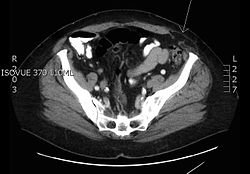Spigelian hernia

Editor-In-Chief: Prab R Tumpati, MD
Obesity, Sleep & Internal medicine
Founder, WikiMD Wellnesspedia &
W8MD medical weight loss NYC and sleep center NYC
| Spigelian hernia | |
|---|---|

| |
| Synonyms | Lateral ventral hernia |
| Pronounce | |
| Specialty | General surgery |
| Symptoms | Abdominal pain, abdominal mass |
| Complications | Bowel obstruction, strangulation |
| Onset | |
| Duration | |
| Types | |
| Causes | Weakness in the Spigelian fascia |
| Risks | Obesity, chronic cough, pregnancy |
| Diagnosis | Physical examination, ultrasound, CT scan |
| Differential diagnosis | Inguinal hernia, femoral hernia, abdominal wall hematoma |
| Prevention | |
| Treatment | Surgical repair |
| Medication | |
| Prognosis | Generally good with treatment |
| Frequency | Rare |
| Deaths | |
Spigelian Hernia[edit]
Introduction[edit]
Spigelian Hernia is a type of Ventral Hernia characterized by the protrusion of aponeurotic fascia through a defect in the abdominal wall at the junction of the linea semilunaris and the arcuate line. This condition results in a bulge in the lower quadrant of the abdomen and is specifically associated with the Spigelian aponeurosis.
Anatomy and Pathophysiology[edit]
Spigelian hernias occur through a defect or weakness in the Spigelian fascia, which is located between the rectus abdominis muscle and the semilunar line. The hernia typically appears below the level of the umbilicus where the abdominal wall is thinner and more vulnerable to defects.
Epidemiology[edit]
This type of hernia is relatively rare and can occur in both men and women. It is most commonly seen in middle-aged and older adults and may be misdiagnosed due to its unusual location and presentation.
Symptoms and Diagnosis[edit]
Symptoms may include pain and a noticeable bulge in the lower abdominal quadrant, which may intensify with straining or physical activity. Diagnosis often requires imaging studies such as ultrasound or CT scans due to the difficulty in clinical diagnosis.
Treatment[edit]
Treatment typically involves surgical repair, either through traditional open surgery or laparoscopic methods. The choice of procedure depends on the size of the hernia and the patient's overall health.
Complications[edit]
If left untreated, Spigelian hernias can lead to complications like incarceration or strangulation of the herniated tissue, necessitating emergency surgery.
Prevention and Lifestyle Modifications[edit]
Preventive measures include maintaining a healthy weight, regular exercise, and avoiding heavy lifting or straining that can increase abdominal pressure.
See Also[edit]
References[edit]
<references/> 1. [Link to a medical journal article on Spigelian Hernia] 2. [Link to a surgical textbook or guideline discussing hernia repair]
External Links[edit]
Ad. Transform your life with W8MD's Budget GLP-1 injections from $75


W8MD offers a medical weight loss program to lose weight in Philadelphia. Our physician-supervised medical weight loss provides:
- Weight loss injections in NYC (generic and brand names):
- Zepbound / Mounjaro, Wegovy / Ozempic, Saxenda
- Most insurances accepted or discounted self-pay rates. We will obtain insurance prior authorizations if needed.
- Generic GLP1 weight loss injections from $75 for the starting dose.
- Also offer prescription weight loss medications including Phentermine, Qsymia, Diethylpropion, Contrave etc.
NYC weight loss doctor appointmentsNYC weight loss doctor appointments
Start your NYC weight loss journey today at our NYC medical weight loss and Philadelphia medical weight loss clinics.
- Call 718-946-5500 to lose weight in NYC or for medical weight loss in Philadelphia 215-676-2334.
- Tags:NYC medical weight loss, Philadelphia lose weight Zepbound NYC, Budget GLP1 weight loss injections, Wegovy Philadelphia, Wegovy NYC, Philadelphia medical weight loss, Brookly weight loss and Wegovy NYC
|
WikiMD's Wellness Encyclopedia |
| Let Food Be Thy Medicine Medicine Thy Food - Hippocrates |
Medical Disclaimer: WikiMD is not a substitute for professional medical advice. The information on WikiMD is provided as an information resource only, may be incorrect, outdated or misleading, and is not to be used or relied on for any diagnostic or treatment purposes. Please consult your health care provider before making any healthcare decisions or for guidance about a specific medical condition. WikiMD expressly disclaims responsibility, and shall have no liability, for any damages, loss, injury, or liability whatsoever suffered as a result of your reliance on the information contained in this site. By visiting this site you agree to the foregoing terms and conditions, which may from time to time be changed or supplemented by WikiMD. If you do not agree to the foregoing terms and conditions, you should not enter or use this site. See full disclaimer.
Credits:Most images are courtesy of Wikimedia commons, and templates, categories Wikipedia, licensed under CC BY SA or similar.
Translate this page: - East Asian
中文,
日本,
한국어,
South Asian
हिन्दी,
தமிழ்,
తెలుగు,
Urdu,
ಕನ್ನಡ,
Southeast Asian
Indonesian,
Vietnamese,
Thai,
မြန်မာဘာသာ,
বাংলা
European
español,
Deutsch,
français,
Greek,
português do Brasil,
polski,
română,
русский,
Nederlands,
norsk,
svenska,
suomi,
Italian
Middle Eastern & African
عربى,
Turkish,
Persian,
Hebrew,
Afrikaans,
isiZulu,
Kiswahili,
Other
Bulgarian,
Hungarian,
Czech,
Swedish,
മലയാളം,
मराठी,
ਪੰਜਾਬੀ,
ગુજરાતી,
Portuguese,
Ukrainian


